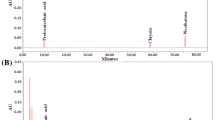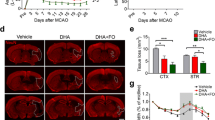Abstract
Both brain-derived neurotrophic factor (BDNF) and microglia activation are involved in the pathogenesis of ischemic stroke. Herein, we attempt to ascertain whether Calycosin, an isoflavonoid, protects against ischemic stroke by modulating the endogenous production of BDNF and/or the microglia activation. This study was a prospective, randomized, blinded and placebo-controlled preclinical experiment. Sprague-Dawley adult rats, subjected to transient focal cerebral ischemia by middle cerebral artery occlusion (MCAO), were treated randomly with 0 (corn oil and/or saline as placebo), 30 mg/kg of Calycosin and/or 1 mg/kg of a tropomyosin-related kinase B (TrkB) receptor antagonist (ANA12) at 1 h after reperfusion and once daily for a total of 7 consecutive days. BDNF and its functional receptor, full-length TrkB (TrkB-FL) levels, the percentage of hypertrophic microglia, tumor necrosis factor-α (TNF-α)-containing microglia, and degenerative and apoptotic neurons in ischemic brain regions were determined 7 days after cerebral ischemia. A battery of functional sensorimotor test was performed over 7 days. Post-stroke Calycosin therapy increased the cerebral expression of BDNF/TrkB, ameliorated the neurological injury and switched the microglia from the activated amoeboid state to the resting ramified state in ischemic stroke rats. However, the beneficial effects of BDNF/ TrkB-mediated Calycosin could be reversed by ANA12. Our data indicate that BDNF/TrkB-mediated Calycosin ameliorates rat ischemic stroke injury by switching the microglia from the activated amoeboid state to the resting ramified state.

Graphical abstract








Similar content being viewed by others
Abbreviations
- BDNF:
-
brain-derived neurotrophic factor
- CBF:
-
cerebral blood flow
- CIV:
-
corrected infarction volume
- d :
-
thickness of the brain slices
- DAPI:
-
4′,6-diamidino-2-phenylindole
- ECA:
-
external carotid artery
- ELISA:
-
enzyme-linked immunosorbent assay
- Iba-1:
-
ionized calcium binding adaptor molecule 1
- ICA:
-
internal carotid artery
- LT:
-
left hemisphere
- MCAO:
-
middle cerebral artery occlusion
- mNSS:
-
modified neurological severity score
- NeuN:
-
neuronal nuclei
- PBS:
-
phosphate-buffered saline
- RA:
-
Radix Astragali
- RI:
-
right side infarct
- RT:
-
right hemisphere
- SD:
-
Sprague-Dawley
- TNF-α:
-
tumor necrosis factor-alpha
- TrkB-FL:
-
full-length tyrosine kinase receptor B
- TTC:
-
2,3,5-triphenyl tetrazolium chloride
- TUNEL:
-
terminal deoxynucleotidyl transferase dUTP nick end labeling
References
Bederson JB, Pitts LH, Germano SM, Nishimura MC, Davis RL, Bartkowski HM (1986) Evaluation of 2,3,5-triphenyltetrazolium chloride as a stain for detection and quantification of experimental cerebral infarction in rats. Stroke 17(6):1304–1308
Bejot Y, Prigent-Tessier A, Cachia C, Giroud M, Mossiat C, Bertrand N, Garnier P, Marie C (2011) Time-dependent contribution of non neuronal cells to BDNF production after ischemic stroke in rats. Neurochem Int 58(1):102–111. https://doi.org/10.1016/j.neuint.2010.10.019
Butler TL, Kassed CA, Sanberg PR, Willing AE, Pennypacker KR (2002) Neurodegeneration in the rat hippocampus and striatum after middle cerebral artery occlusion. Brain Res 929(2):252–260
Cazorla M, Premont J, Mann A, Girard N, Kellendonk C, Rognan D (2011) Identification of a low-molecular weight TrkB antagonist with anxiolytic and antidepressant activity in mice. J Clin Invest 121(5):1846–1857. https://doi.org/10.1172/jci43992
Chen J, Li Y, Wang L, Zhang Z, Lu D, Lu M, Chopp M (2001) Therapeutic benefit of intravenous administration of bone marrow stromal cells after cerebral ischemia in rats. Stroke 32(4):1005–1011
Chen A, Xiong LJ, Tong Y, Mao M (2013) The neuroprotective roles of BDNF in hypoxic ischemic brain injury. Biomed Rep 1(2):167–176. https://doi.org/10.3892/br.2012.48
Chen HH, Zhang N, Li WY, Fang MR, Zhang H, Fang YS, Ding MX, Fu XY (2015) Overexpression of brain-derived neurotrophic factor in the hippocampus protects against post-stroke depression. Neural Regen Res 10(9):1427–1432. https://doi.org/10.4103/1673-5374.165510
Chen SD, Wu CL, Hwang WC, Yang DI (2017) More insight into BDNF against Neurodegeneration: anti-apoptosis, anti-oxidation, and suppression of autophagy. Int J Mol Sci 18(3). https://doi.org/10.3390/ijms18030545
Chio CC, Lin MT, Chang CP (2015) Microglial activation as a compelling target for treating acute traumatic brain injury. Curr Med Chem 22(6):759–770
Denker SP, Ji S, Dingman A, Lee SY, Derugin N, Wendland MF, Vexler ZS (2007) Macrophages are comprised of resident brain microglia not infiltrating peripheral monocytes acutely after neonatal stroke. J Neurochem 100(4):893–904. https://doi.org/10.1111/j.1471-4159.2006.04162.x
Ding Y, Li J, Lai Q, Rafols JA, Luan X, Clark J, Diaz FG (2004) Motor balance and coordination training enhances functional outcome in rat with transient middle cerebral artery occlusion. Neuroscience 123(3):667–674
Durukan A, Tatlisumak T (2007) Acute ischemic stroke: overview of major experimental rodent models, pathophysiology, and therapy of focal cerebral ischemia. Pharmacol Biochem Behav 87(1):179–197. https://doi.org/10.1016/j.pbb.2007.04.015
Ferrer I, Krupinski J, Goutan E, Marti E, Ambrosio S, Arenas E (2001) Brain-derived neurotrophic factor reduces cortical cell death by ischemia after middle cerebral artery occlusion in the rat. Acta Neuropathol 101(3):229–238. https://doi.org/10.1007/s004010000268
Fu S, Gu Y, Jiang JQ, Chen X, Xu M, Chen X, Shen J (2014) Calycosin-7-O-beta-D-glucoside regulates nitric oxide /caveolin-1/matrix metalloproteinases pathway and protects blood-brain barrier integrity in experimental cerebral ischemia-reperfusion injury. J Ethnopharmacol 155(1):692–701. https://doi.org/10.1016/j.jep.2014.06.015
Gartshore G, Patterson J, Macrae IM (1997) Influence of ischemia and reperfusion on the course of brain tissue swelling and blood-brain barrier permeability in a rodent model of transient focal cerebral ischemia. Exp Neurol 147(2):353–360. https://doi.org/10.1006/exnr.1997.6635
Guo C, Tong L, Xi M, Yang H, Dong H, Wen A (2012) Neuroprotective effect of calycosin on cerebral ischemia and reperfusion injury in rats. J Ethnopharmacol 144(3):768–774. https://doi.org/10.1016/j.jep.2012.09.056
Habtemariam S (2018) The brain-derived neurotrophic factor in neuronal plasticity and neuroregeneration: new pharmacological concepts for old and new drugs. Neural Regen Res 13(6):983–984. https://doi.org/10.4103/1673-5374.233438
Hu X, Li P, Guo Y, Wang H, Leak RK, Chen S, Gao Y, Chen J (2012) Microglia/macrophage polarization dynamics reveal novel mechanism of injury expansion after focal cerebral ischemia. Stroke 43(11):3063–3070. https://doi.org/10.1161/strokeaha.112.659656
Iadecola C, Anrather J (2011) The immunology of stroke: from mechanisms to translation. Nat Med 17(7):796–808. https://doi.org/10.1038/nm.2399
Jin Q, Cheng J, Liu Y, Wu J, Wang X, Wei S, Zhou X, Qin Z, Jia J, Zhen X (2014) Improvement of functional recovery by chronic metformin treatment is associated with enhanced alternative activation of microglia/macrophages and increased angiogenesis and neurogenesis following experimental stroke. Brain Behav Immun 40:131–142. https://doi.org/10.1016/j.bbi.2014.03.003
Kokaia Z, Zhao Q, Kokaia M, Elmer E, Metsis M, Smith ML, Siesjo BK, Lindvall O (1995) Regulation of brain-derived neurotrophic factor gene expression after transient middle cerebral artery occlusion with and without brain damage. Exp Neurol 136(1):73–88. https://doi.org/10.1006/exnr.1995.1085
Konsman JP, Drukarch B, Van Dam AM (2007) (Peri)vascular production and action of pro-inflammatory cytokines in brain pathology. Clin Sci (Lond) 112(1):1–25. https://doi.org/10.1042/cs20060043
Kurozumi K, Nakamura K, Tamiya T, Kawano Y, Ishii K, Kobune M, Hirai S, Uchida H, Sasaki K, Ito Y, Kato K, Honmou O, Houkin K, Date I, Hamada H (2005) Mesenchymal stem cells that produce neurotrophic factors reduce ischemic damage in the rat middle cerebral artery occlusion model. Mol Ther 11(1):96–104. https://doi.org/10.1016/j.ymthe.2004.09.020
Lalancette-Hebert M, Swarup V, Beaulieu JM, Bohacek I, Abdelhamid E, Weng YC, Sato S, Kriz J (2012) Galectin-3 is required for resident microglia activation and proliferation in response to ischemic injury. J Neurosci 32(30):10383–10395. https://doi.org/10.1523/jneurosci.1498-12.2012
Lee S, Lee M, Hong Y, Won J, Lee Y, Kang SG, Chang KT, Hong Y (2014) Middle cerebral artery occlusion methods in rat versus mouse models of transient focal cerebral ischemic stroke. Neural Regen Res 9(7):757–758. https://doi.org/10.4103/1673-5374.131582
Li K, Gao F, Li Z, Qin X, Sun H, Xing J, Zhang L, Du G (2015) Potential quality evaluation method for Radix Astragali based on sweetness indicators. Molecules 20(2):3129–3145. https://doi.org/10.3390/molecules20023129
Lin TN, He YY, Wu G, Khan M, Hsu CY (1993) Effect of brain edema on infarct volume in a focal cerebral ischemia model in rats. Stroke 24(1):117–121
Lin W, Hsuan YC, Lin MT, Kuo TW, Lin CH, Su YC, Niu KC, Chang CP, Lin HJ (2017) Human umbilical cord Mesenchymal stem cells preserve adult newborn neurons and reduce neurological injury after cerebral ischemia by reducing the number of hypertrophic microglia/macrophages. Cell Transplant 26(11):1798–1810. https://doi.org/10.1177/0963689717728936
Liu X, Wang X, Li A, Jiao X (2016) Effect of mesenchymal stem cell transplantation on brain-derived neurotrophic factor expression in rats with Tourette syndrome. Exp Ther Med 11(4):1211–1216. https://doi.org/10.3892/etm.2016.3059
Longa EZ, Weinstein PR, Carlson S, Cummins R (1989) Reversible middle cerebral artery occlusion without craniectomy in rats. Stroke 20(1):84–91
Mantovani A, Sica A, Locati M (2005) Macrophage polarization comes of age. Immunity 23(4):344–346. https://doi.org/10.1016/j.immuni.2005.10.001
Miller AP, Shah AS, Aperi BV, Budde MD, Pintar FA, Tarima S, Kurpad SN, Stemper BD, Glavaski-Joksimovic A (2015) Effects of blast overpressure on neurons and glial cells in rat organotypic hippocampal slice cultures. Front Neurol 6:20. https://doi.org/10.3389/fneur.2015.00020
Moskowitz MA, Lo EH, Iadecola C (2010) The science of stroke: mechanisms in search of treatments. Neuron 67(2):181–198. https://doi.org/10.1016/j.neuron.2010.07.002
Mouihate A (2014) TLR4-mediated brain inflammation halts neurogenesis: impact of hormonal replacement therapy. Front Cell Neurosci 8:146. https://doi.org/10.3389/fncel.2014.00146
Perez-de Puig I, Miro F, Salas-Perdomo A, Bonfill-Teixidor E, Ferrer-Ferrer M, Marquez-Kisinousky L, Planas AM (2013) IL-10 deficiency exacerbates the brain inflammatory response to permanent ischemia without preventing resolution of the lesion. J Cereb Blood Flow Metab 33(12):1955–1966. https://doi.org/10.1038/jcbfm.2013.155
Schallert T, Fleming SM, Leasure JL, Tillerson JL, Bland ST (2000) CNS plasticity and assessment of forelimb sensorimotor outcome in unilateral rat models of stroke, cortical ablation, parkinsonism and spinal cord injury. Neuropharmacology 39(5):777–787
Schilling M, Besselmann M, Muller M, Strecker JK, Ringelstein EB, Kiefer R (2005) Predominant phagocytic activity of resident microglia over hematogenous macrophages following transient focal cerebral ischemia: an investigation using green fluorescent protein transgenic bone marrow chimeric mice. Exp Neurol 196(2):290–297. https://doi.org/10.1016/j.expneurol.2005.08.004
Tang Y, Le W (2016) Differential roles of M1 and M2 microglia in neurodegenerative diseases. Mol Neurobiol 53(2):1181–1194. https://doi.org/10.1007/s12035-014-9070-5
Tejeda GS, Diaz-Guerra M (2017) Integral characterization of defective BDNF/TrkB Signalling in neurological and psychiatric disorders leads the way to new therapies. Int J Mol Sci 18(2):268. https://doi.org/10.3390/ijms18020268
Wurzelmann M, Romeika J, Sun D (2017) Therapeutic potential of brain-derived neurotrophic factor (BDNF) and a small molecular mimics of BDNF for traumatic brain injury. Neural Regen Res 12(1):7–12. https://doi.org/10.4103/1673-5374.198964
Xiong X, Barreto GE, Xu L, Ouyang YB, Xie X, Giffard RG (2011) Increased brain injury and worsened neurological outcome in interleukin-4 knockout mice after transient focal cerebral ischemia. Stroke 42(7):2026–2032. https://doi.org/10.1161/strokeaha.110.593772
Xiong XY, Liu L, Yang QW (2016) Functions and mechanisms of microglia/macrophages in neuroinflammation and neurogenesis after stroke. Prog Neurobiol 142:23–44. https://doi.org/10.1016/j.pneurobio.2016.05.001
Zhong L, Luo F, Zhao W, Feng Y, Wu L, Lin J, Liu T, Wang S, You X, Zhang W (2016) Propofol exposure during late stages of pregnancy impairs learning and memory in rat offspring via the BDNF-TrkB signalling pathway. J Cell Mol Med 20(10):1920–1931. https://doi.org/10.1111/jcmm.12884
Acknowledgments
The authors would like to thank Ms. Meng-Tsung Ho for her excellent editorial assistance in manuscript preparation.
Funding
This work was supported by grants from the Ministry of Science and Technology (Taiwan) (MOST 107-2314-B-384-004) and Chi Mei Medical Center (Tainan, Taiwan) (CMFHT10504).
Author information
Authors and Affiliations
Contributions
C.C.H. and W.P.L. performed the MCAO surgeries and western blotting. T.W.K. performed the rat behavioral tests and immunohistochemical staining. C.C.H. and H.J.L. designed and coordinated the study. C.P.C. and H.J.L. conceived the study and wrote the manuscript. All authors read and approved the final manuscript.
Corresponding authors
Ethics declarations
Ethics Approval and Consent to Participate
All animal research was ethically approved by the Institutional Animal Care and Use Committee of Chi Mei Medical Center (IACUC approved no. 105110328). Experiments adhered to guidelines from the National Institutes of Health Guide for the Care and Use of Laboratory Animals.
Consent for Publication
Not applicable.
Availability of Data and Material
The data that support the findings of this study are available from the corresponding author upon reasonable request.
Competing Interests
The authors declare that there is no conflict of interest.
Additional information
Publisher’s Note
Springer Nature remains neutral with regard to jurisdictional claims in published maps and institutional affiliations.
Electronic supplementary material
ESM 1
(DOCX 755 kb)
Rights and permissions
About this article
Cite this article
Hsu, CC., Kuo, TW., Liu, WP. et al. Calycosin Preserves BDNF/TrkB Signaling and Reduces Post-Stroke Neurological Injury after Cerebral Ischemia by Reducing Accumulation of Hypertrophic and TNF-α-Containing Microglia in Rats. J Neuroimmune Pharmacol 15, 326–339 (2020). https://doi.org/10.1007/s11481-019-09903-9
Received:
Accepted:
Published:
Issue Date:
DOI: https://doi.org/10.1007/s11481-019-09903-9




